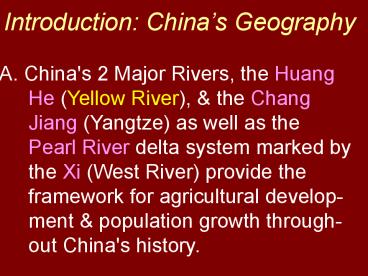Introduction: Chinas Geography - PowerPoint PPT Presentation
1 / 12
Title:
Introduction: Chinas Geography
Description:
He (Yellow River), & the Chang. Jiang (Yangtze) as well as the ... River, & eventually spread southward to the Chang Jiang (Yangtze) and Xi rivers. ... – PowerPoint PPT presentation
Number of Views:75
Avg rating:3.0/5.0
Title: Introduction: Chinas Geography
1
Introduction Chinas Geography A. China's 2
Major Rivers, the Huang He (Yellow
River), the Chang Jiang (Yangtze) as
well as the Pearl River delta system
marked by the Xi (West River) provide the
framework for agricultural develop-
ment population growth through- out
China's history. The fourth major river in the
north, Heilong Jiang (Amur River) is important as
it forms China's border with the Soviet Union and
has been the site of confrontation between these
two powers today. Geography Population / 3
2
- The 4th major river in the north, Heilong Jiang
(Amur River) is important as it forms - China's border with the Russia and has been the
site of confrontation between these two powers
today.
3
B. The course of the Yellow River
has changed several times in China's
history, notably 1194 again in 1853,
wreaking untold disasters. Water
control is one of the major
challenges in China today, to
prevent both flooding and drought two
natural occur- rences that have plagued
the Chinese people throughout history.
4
- C. Looking at the map of Historical Borders the
map showing the Major Rivers highlight the
import-ant fact that the earliest civilizations
developed along river valleys. The cradle of
Chinese civilization, Pan Po, was located along
the Huang - He in the North China Plain. The first dynasty
of the Shang (c. 1600-1027 BC) was also situated
around the Yellow River, eventually spread
southward to the Chang Jiang (Yangtze) and Xi
rivers.
5
- D. The Chinese of this early period had to
correct deficiencies in the physical geography to
defend themselves and further unify the country. - The Great Wall was first completedduring the
Qin (Ch'in) dynasty (221-206 BC) when segments of
the wall existing from earlier periods were
connected. Since the Chinese had no mountains to
their north, it was the direction from which they
were invaded. The Great Wall served as a
defensive purpose against invading "barbarians."
6
The Grand Canal was first constructed around 605
AD to con-nect the Yellow River in the north
the Yangtze River in the south. Since these 2
great rivers run east-west, there is no natural
communication north-south except by way of the
ocean. The Chinese constructed the Canal to have
a safe, inland water route between the 2 major
rivers.
7
E. The west of China is comprised of Mountains
and Deserts, as well as plateaus, and does not
provide much arable land for agriculture.
Historically therefore, the civilization that
grew up in the east of China was not surrounded
in ancient history by other major civilizations.
To this extent the Chinese were "isolated" from
competing civilizations. This geographical fact
is important to emember when discussing the
Western encroachment on China.
8
The mountains and deserts of the West limited
contact between China and other major centers of
civilization in the Middle East and South Asia.
The culture of China thus combined withother
Asian countries creating a cultural sphere known
as East Asia.
9
F. Looking at the map of Surrounding Nations it
is possible to identify Chinas neighbors.
Historically, China's cultural and political
influence over Korea, Japan, Vietnam, and to a
lesserextent, Laos, Thailand, and Burma, was
great.
10
Use the maps of China's Mountains and Deserts,
and of China's Population Density to demonstrate
why contact with these countries was greater than
contact with the Indian subcontinentor China's
neighbors to the west. The large number of
countries with which China shares a border makes
Chinese foreign policy especially complex (unlike
the U.S., for example).
11
G. Like many other countries, the Historical
Borders of China have not always been thesame.
12
Under the Han dynasty (202 BC - 220 AD), China's
great historical empire, these early boundaries
were significantly expanded. The extent of
China's territory was greatest under the last
dynasty of the Qing(Ch'ing) or Manchus.
1644-1912. China's territory was more extensive
under the Qing empire than it is today.































